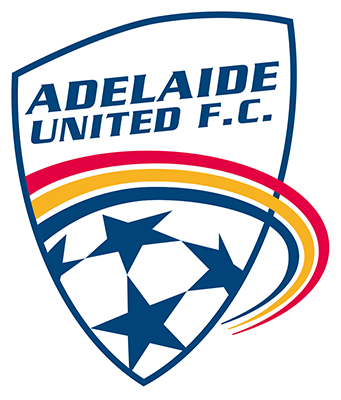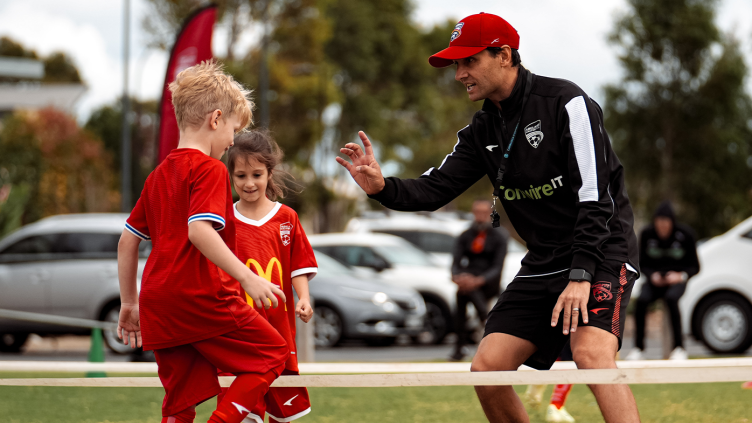In a couple of weeks Adelaide United will celebrate their tenth birthday. They’re one of the few clubs in the A-League who managed to survive from the old NSL.
In a couple of weeks Adelaide United will celebrate their tenth birthday. They’re one of the few clubs in the A-League who managed to survive from the old NSL, although they’ve seen significant change since local philanthropist Gordon Pickard formed the club a decade ago. To be honest, the club has missed Gordon-s entrepreneurial nous – for me, they’ve never really been the same since he left after the inaugural A-League season. I’ll talk about that later.
In a city where Aussie Rules is God, Adelaide United changed the face of the sport in South Australia when they played their first game on October 17, 2003. Hindmarsh Stadium was filled to the brim for the visit of one of my former clubs, Brisbane Strikers. The stadium’s official capacity is around 15,000, but guesstimates from informed sources put the number inside the ground at 17,500 – with another 5,000 outside. The fans were virtually hanging from the rafters, and it was an incredible experience for those lucky enough to be there.
United, by virtue of the name, represented all of Adelaide, and South Australia, and the punters embraced it. The birth of the club finally put an end to the perennial infighting that symbolised South Australia’s involvement during much of the NSL era. In truth, this was indicative of the NSL overall – Perth Glory excepted.
The arrival of Adelaide United changed everything. It was a virtual ménage au trois between the South Australian Soccer Federation, the fans, and the local state league clubs. Everyone felt a sense of ownership. Everyone got a piece of the action. We were – as the slogan said – the ”People-s Team”. And having a squad full of local players helped strengthen the sense of identity.
Fresh from the presidency of Soccer Australia, local businessman Basil Scarsella became the inaugural chairman of Adelaide United, and his knowledge of the intricate web of politics within the game helped negotiate a delayed start to what was to be the only NSL season for the new club, and the final season of the NSL itself.
More importantly, Basi provided a clear path through the minefield of local football politics. But it was Gordon who was the driving force, the man who made the club an instant success on and off the field. Gordon used his considerable influence to bring in the sponsorship dollars, and he brought us respect from the local business community and mainstream SA sporting public. I remember the launch at the Convention Centre – there were over a thousand people there, including hundreds of local dignitaries.
That was a real first for the game in Adelaide, a long way from the chook raffles and pitch-side barbie days of yesteryear (although I must mention Adelaide United did resurrect the sausage sizzle at the conclusion of last season!). We finished a credible third in our debut season, and then got ready for the brave new world of the A-League.
Pickard reckons life was easy in the NSL compared to the massively regulated regime that was the A-League in season one. He once said to me: “You could almost do what you wanted.” Maybe that-s why the NSL was such a basket case – because too many clubs did just that, and the management sat back and let them get away with it. Be that as it may, Gordon stuck it out for 15 months while Frank Lowy cleaned up the debris of the NSL and launched the A-League.
By November 2004, when pre-season began, Scarsella had moved on and Gordon had become sole owner of the licence. During that long lay-off between the two competitions he kept the group together by employing staff in his office, and getting the players to play in the local state league. A lot of planning went into that first season of the A-League because we had plenty of time to do it. We wanted to get it right. I think we did. We won the premiership with games to spare, but we blew our chances of the championship when we lost to Central Coast Mariners in the preliminary final. But overall, it was a successful second season, our first in the A-League.
So why did it work? Simple – the culture. Gordon believed management had their tasks, and the football department had theirs. We didn-t interfere with each other. I remember him saying to me once: “I-m the builder, and you’re the coach. I won-t tell you how to coach and I don-t expect you to tell me how to build.” No problem!
That’s how we developed the culture – helped by some strong leadership among the players with the likes of Ross Aloisi and Carl Veart. Players couldn-t run off to management and sulk or talk behind people-s backs as many are prone to do. Even when they tried, and a few did, they hit a brick wall. That-s how it was and how it should be.
Since those formative years much has changed. The current ownership is the third. It’s been seven years since Gordon sold out to Nick Bianco and the pickings have been lean, especially during the past three seasons under the current ownership.
Previously the club had won a premiership, made two grand finals, won two pre-season tournaments, and lost an AFC Champions League final. Not bad on paper, but could more have been achieved? Yes.
Sadly, Adelaide Unitd have become more famous for the catastrophes rather than the achievements, starting from Aurelio Vidmar “pissant town” rant in February, 2009. I can tell you now, it-s not the town that-s “pissant”. The club has been in court no less than three times battling unfair dismissal claims – twice under Bianco-s reign. As always, the only people who benefit are the lawyers.
Last season, I resigned as coach on matters of principle. So did an independent committee assembled to select my replacement. And we can’t forget how Eugene Galekovic, the captain, had plenty to say about the management in a post-season explosion in front of the cameras.
There’s been way too much instability, pure and simple. Clubs are about people, and outcomes reflect this. Too many good people have left the coaching staff at Adelaide United. Aurelio and Tony Vidmar, Joe Mullen and Carl Veart are all ex-players who represented the club with distinction, but for various reasons are no longer there.
Just recently Sean Tagg, one of the best strength and conditioning coaches in the country, resigned for the second time. There’s been way too many players come and go as well – successful clubs don’t revamp their squads every season. And these days, there are precious few local players left on the list.
The A-League needs a successful Adelaide United. So does the city, and the state. There’s been talk lately of a second team in Adelaide, but right now the city is not big enough, or prosperous enough, to support two A-League sides. In the meantime Adelaide United need to get on with the business of football – we’ve had enough of the rhetoric. This season they’ve got yet another opportunity to build something successful. I hope they do.
For the sake sake of all the blood, sweat and tears that have gone into creating and building my hometown club, I’d love a season without scandal, without rancour. Let’s celebrate the 10th anniversary by achieving the sort of outcomes we dreamed of all those years ago.




